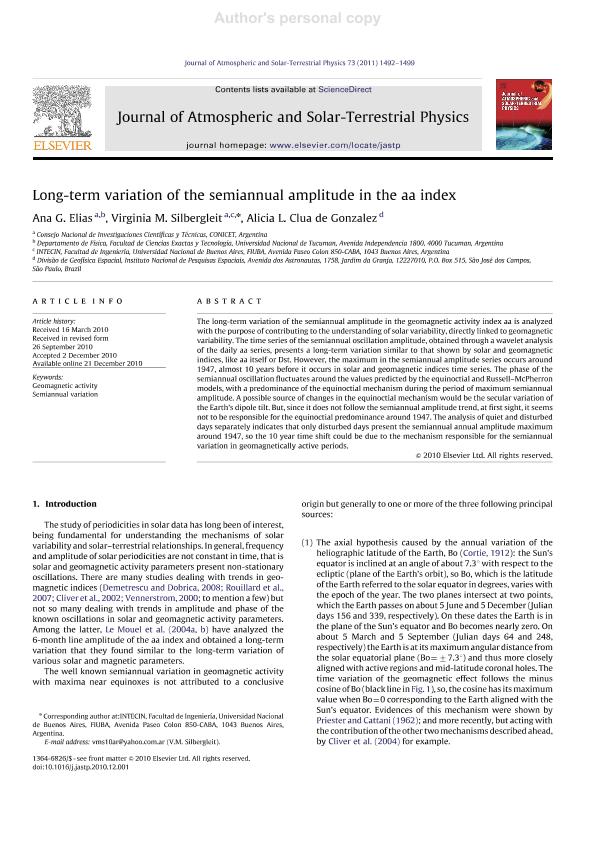Mostrar el registro sencillo del ítem
dc.contributor.author
Elias, Ana Georgina

dc.contributor.author
Silbergleit, Virginia Mabel

dc.contributor.author
Clua de Gonzalez, Alicia L.
dc.date.available
2019-06-03T18:24:20Z
dc.date.issued
2011-07
dc.identifier.citation
Elias, Ana Georgina; Silbergleit, Virginia Mabel; Clua de Gonzalez, Alicia L.; Long-term variation of the semiannual amplitude in the aa index; Elsevier; Journal of Atmospheric and Solar-Terrestrial Physics; 73; 11; 7-2011; 1492-1499
dc.identifier.issn
1364-6826
dc.identifier.uri
http://hdl.handle.net/11336/77548
dc.description.abstract
The long-term variation of the semiannual amplitude in the geomagnetic activity index aa is analyzed with the purpose of contributing to the understanding of solar variability, directly linked to geomagnetic variability. The time series of the semiannual oscillation amplitude, obtained through a wavelet analysis of the daily aa series, presents a long-term variation similar to that shown by solar and geomagnetic indices, like aa itself or Dst. However, the maximum in the semiannual amplitude series occurs around 1947, almost 10 years before it occurs in solar and geomagnetic indices time series. The phase of the semiannual oscillation fluctuates around the values predicted by the equinoctial and Russell–McPherron models, with a predominance of the equinoctial mechanism during the period of maximum semiannual amplitude. A possible source of changes in the equinoctial mechanism would be the secular variation of the Earth's dipole tilt. But, since it does not follow the semiannual amplitude trend, at first sight, it seems not to be responsible for the equinoctial predominance around 1947. The analysis of quiet and disturbed days separately indicates that only disturbed days present the semiannual annual amplitude maximum around 1947, so the 10 year time shift could be due to the mechanism responsible for the semiannual variation in geomagnetically active periods.
dc.format
application/pdf
dc.language.iso
eng
dc.publisher
Elsevier

dc.rights
info:eu-repo/semantics/openAccess
dc.rights.uri
https://creativecommons.org/licenses/by-nc-sa/2.5/ar/
dc.subject
Geomagnetic Activity
dc.subject
Wavelets
dc.subject
Solar Activity
dc.subject
Periodicities
dc.subject.classification
Meteorología y Ciencias Atmosféricas

dc.subject.classification
Ciencias de la Tierra y relacionadas con el Medio Ambiente

dc.subject.classification
CIENCIAS NATURALES Y EXACTAS

dc.title
Long-term variation of the semiannual amplitude in the aa index
dc.type
info:eu-repo/semantics/article
dc.type
info:ar-repo/semantics/artículo
dc.type
info:eu-repo/semantics/publishedVersion
dc.date.updated
2019-06-03T14:33:38Z
dc.journal.volume
73
dc.journal.number
11
dc.journal.pagination
1492-1499
dc.journal.pais
Reino Unido

dc.journal.ciudad
Londres
dc.description.fil
Fil: Elias, Ana Georgina. Universidad Nacional de Tucumán; Argentina. Consejo Nacional de Investigaciones Científicas y Técnicas. Centro Científico Tecnológico Conicet - Tucumán; Argentina
dc.description.fil
Fil: Silbergleit, Virginia Mabel. Universidad de Buenos Aires. Facultad de Ingeniería; Argentina. Consejo Nacional de Investigaciones Científicas y Técnicas; Argentina
dc.description.fil
Fil: Clua de Gonzalez, Alicia L.. Instituto Nacional de Pesquisas Espaciais; Brasil
dc.journal.title
Journal of Atmospheric and Solar-Terrestrial Physics

dc.relation.alternativeid
info:eu-repo/semantics/altIdentifier/url/http://www.sciencedirect.com/science/article/pii/S1364682610003640
dc.relation.alternativeid
info:eu-repo/semantics/altIdentifier/doi/https://dx.doi.org/10.1016/j.jastp.2010.12.001
Archivos asociados
